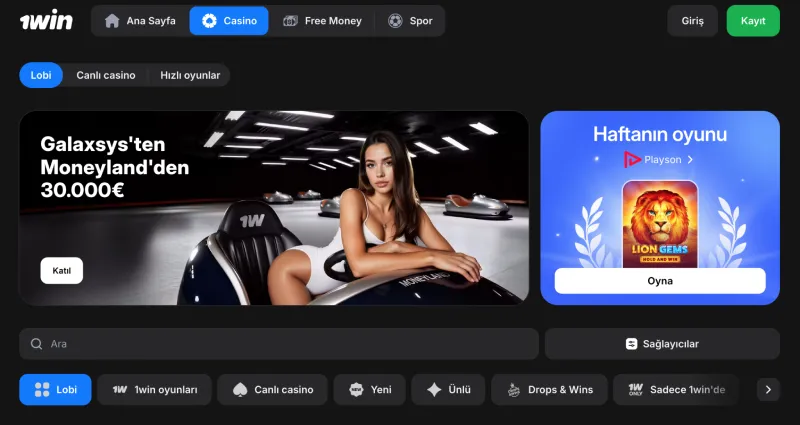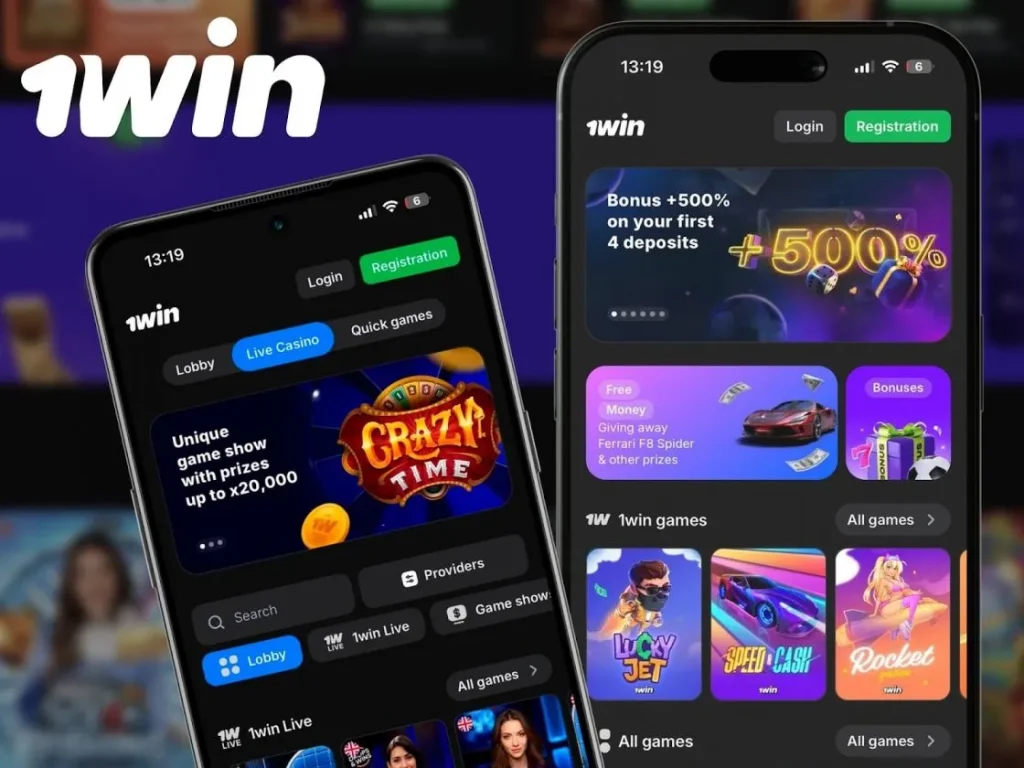1win Türkiye, spor bahisleri ve casino oyunları hayranları için en iyi çevrimiçi platformlardan biridir. Sitede 13.000’den fazla oyun ve dört düzine spor dalında bahis var.
Resmi siteye erişmek için bir hesap oluşturmanız ve yetkilendirmeniz yeterlidir. Hemen ardından hesabınıza para yükleyebilir ve örneğin spor bahisleri yapabilirsiniz. Platformun kendisi güvenilirlik ve kullanım kolaylığı ile karakterizedir. Spor bahislerindeki rekabetçi oranlar ve 1win casino’daki zengin oyun seçenekleri sayesinde dikkat çekiyor. Site, kullanıcı deneyimini aşağıdaki avantajlarla tamamlayarak hem yeni hem de deneyimli oyuncular için çekici bir ortam yaratır:
- Hızlı finansal işlemler.
- 7/24 teknik destek.
- Güncellenmiş aynalar aracılığıyla sürekli erişim.
Tüm bunlar 1win’i kumar meraklıları için pratik bir seçim haline getiriyor. Ancak 1win giriş yapmadan önce, özellikleri hakkında daha fazla bilgi edinmeyi teklif eder, bunlar bir tablo şeklinde toplanır.
| 🎯 Marka | 1win |
|---|---|
| 📜 Kuruluş yılı | 2016 |
| 📕 Lisans | Curaçao (8048/JAZ2018-040) |
| 🎲 Şirket sahibi | NextGen Development Labs Ltd |
| 🇬🇧 Dil sürümleri | Türkçe, İngilizce, Rusça ve diğerleri |
| 💳 Ödeme sistemleri | Papara Cüzdan, Express Havale, Vip Havale, PayCO, HayHay, PopyPara, Paybol, Parolapara, Paratim, Troy, Papel, Banka Havalesi, Binance Pay, Peple, Kripto Para |
| 🏧 Minimum depozito | 50 TL |
| 💰 Minimum para çekme miktarı | 50 TL |
| ⚽ Spor bahisleri | Futbol, Basketbol, Tenis, Siber Sporlar ve diğerleri |
| 🎰 Mevcut oyunlar | Slotlar, Canlı Casino, Masa Oyunları, Crash Oyunları |
| 🕹️ Sağlayıcılar | Pragmatic Play, NetEnt, Evolution Gaming, SmartSoft Gaming, vb. |
| 💸 Hoşgeldin Bonusu | İlk para yatırma işlemlerinde +%500’e kadar |
| 🌐 Yedek Site | https://1win.pro |
| 📲 Mobil uygulama | Android için (APK dosyası), iOS için (mobil sürüm) |
| 🛠️ Teknik destek | 7/24 Çevrimiçi Sohbet, E-posta |
Geriye kalan tek şey bir hesap oluşturmak ve platformun işlevselliğini kendiniz test etmektir.
1win Platformuna Güvenebilir misiniz

1win resmi sitesi güvenilirdir, 8048/JAZ2018-040 numaralı Curaçao lisansı temelinde faaliyet göstermektedir ve hizmetlerini 10 yılı aşkın süredir sunmaktadır. Bu süre zarfında, kaynak ideal bir itibar kazanmıştır.
1win Türkiye 2016 yılında faaliyete geçti ve kısa sürede online bahis ve casino pazarında önemli bir uluslararası oyuncu olarak tanındı. 1win Türkiye’nin popülerliği çeşitli faktörlerden kaynaklanmaktadır:
- 40’tan fazla spor dalında binlerce spor etkinliği;
- Çeşitli casino oyunları koleksiyonu 13.000’den fazla oyun;
- Kullanıcı dostu ve anlaşılır arayüz.
1win güvenilir mi? Güvenilirlik, şeffaf bir ödeme politikası ve gelişmiş veri güvenliği önlemleri ile desteklenmektedir. Platformun ana hizmetleri şunları içerir: Sürekli erişim sağlamak için sitenin güncel aynaları aktif olarak kullanılmaktadır.
1win’de Spor Bahisleri Hakkında Her Şey

1win bet büyük bir spor bahisleri bölümüne sahiptir. Mevcut 40’tan fazla spor olduğu için istediğiniz her şeye bahis oynayabilirsiniz.
- Futbol hem bizim şampiyonluklarımız hem de Şampiyonlar Ligi’dir.
- Basketbol – NBA ve diğer maçlar.
- Tenis, voleybol ve hatta Dota 2 veya CS:GO gibi popüler siber spor turnuvaları.
1win spor bahisler oranlar genellikle iyidir, bu nedenle bahis şirketi çok elverişli görünüyor. Ayrıca maç sırasında da 1win betting gidebilirsiniz – işte bu harika! Oradaki teklifler duruma göre anında değişir. Doğru kararı vermek için istatistikleri izleyebilirsiniz. Maçı izlerken aynı zamanda 1win bahis yapmak size heyecan katar.
Casino Bölümüne Genel Bakış: Oyuncular için Neler Sunuluyor
1win casino bölümü etkileyici bir oyun çeşitliliği sunar – 13.000’in üzerinde. Kullanıcılar şunlara erişebilir:
- En iyi geliştiricilerden binlerce slot (örneğin Sweet Bonanza, Gates of Olympus).
- Klasik masa 1win games: rulet, blackjack, poker.
- Popüler çarpışma oyunları arasında JetX, Lucky Jet, Speed n Cash.
Yüksek kaliteli oyunlar sunan sağlayıcılar arasında NetEnt, Pragmatic Play, Evolution Gaming ve diğerleri bulunmaktadır.
Canlı krupiyeli 1win online casino özel bir yere sahiptir. Gerçek bir kumar salonu atmosferi yaratarak rulet, blackjack ve bakara masalarında gerçek zamanlı olarak profesyonel krupiyelerle etkileşime girmenizi sağlar. Canlı yayın, tamamen sürükleyici bir oyun deneyimi sağlar.
1win’e Kaydolmak: Türk Oyuncular için Adım Adım Rehber
Oynamaya başlamak için, 1win güncel giriş kullanarak siteye giriş yapmanız gerekir. Bazen yerel düzenlemeler nedeniyle ana adres mevcut olmayabilir, o zaman çalışan bir ayna arayın. Bu, çok uzun süre beklemeden 1win official ulaşmanızı sağlayacaktır.
1win, hesap oluşturmak için çeşitli yollar sunar:
- Sosyal medya aracılığıyla. Sosyal medya hesabınızla bağlantılı.
- Posta ve telefon ile. Formu doldurun, para birimini ve bir şifre belirleyin.
1win TR’ye kaydolduktan sonra, doğrulama işleminden geçmeniz önerilir. Bu, örneğin belge yükleyerek kimliğinizin doğrulanmasıdır. Bu prosedür hesabınızın ve paranızın güvenliği için önemlidir. Belgelerinizi 1win giris işleminden hemen sonra göndermenizi tavsiye ederiz, böylece kazancınızı beklemeden çekebilirsiniz. Doğrulama, 1win official site güvenli bir şekilde çalışmasına ve dolandırıcılığı önlemesine yardımcı olur.
1win’de Para Yatırma ve Çekme Hakkında Her Şey: Ödeme Yöntemleri ve Limitler
1win register kaldığında, yetki vermek ve para yatırmak kalır. Bunu yapmak için, sadece giriş yapın ve 1win deposit bölümüne gidin. Aşağıdaki tabloda gerçek limitler.
| Depozito | Limitler (TRY) | Zaman |
|---|---|---|
| Papara Wallet | TRY 500 – TRY 500,000 | Anında |
| Express Havale | TRY 50 – TRY 250,000 | Anında |
| Vip Havale | TRY 100 – TRY 250,000 | Anında |
| PayCO | TRY 500 – TRY 65,000 | Anında |
| HayHay | TRY 100 – TRY 100,000 | Anında |
| PopyPara | TRY 50 – TRY 50,000 | Anında |
| Paybol | TRY 50 – TRY 30,000 | Anında |
| Parolapara | TRY 100 – TRY 250,000 | Anında |
| Paratim | TRY 100 – TRY 10,000 | Anında |
| Troy | TRY 200 – TRY 950 | Anında |
| Papel | TRY 50 – TRY 250,000 | Anında |
| Bank Transfer | TRY 50 – TRY 50,000 | Anında |
| Binance Pay | TRY 550 – TRY 1,000,000 | Anında |
| Peple | TRY 100 – TRY 30,000 | Anında |
| Kripto Para | Para birimine göre değişir | 15 dakikaya kadar |
1win yasal mı? Evet, platform yalnızca doğrulanmış ödeme yöntemlerini kullanır.
1win withdrawal için işlem limitleri aşağıdaki gibidir.
| Para Çekme | Limitler (TRY) | Zaman |
|---|---|---|
| Visa/MasterCard | TRY 500 – TRY 50,000 | 72 saate kadar |
| Papara Wallet | TRY 500 – TRY 10,000 | 72 saate kadar |
| Express Havale | TRY 50 – TRY 250,000 | 72 saate kadar |
| PopyPara | TRY 500 – TRY 10,000 | 72 saate kadar |
| Bank Transfer | TRY 500 – TRY 50,000 | 72 saate kadar |
| PayCO | TRY 500 – TRY 30,000 | 72 saate kadar |
| HayHay Banks | TRY 50 – TRY 250,000 | 72 saate kadar |
| Kripto Para | Para birimine göre değişir | Anında |
1win withdrawal time ile ilgili olarak, düzenleme 72 saate kadardır.
Telefonunuzdan Bahis Oynamak: Android ve iOS için Bir Çözüm
1win app, doğrudan telefonunuzdan bahis yapmanıza ve casino oyunları oynamanıza olanak tanır.
Nasıl indirilir:
- Android için: 1win apk dosyasını 1win resmi web sitesinden indirin. Bu size tüm özelliklere erişim sağlayacaktır.
- iOS için: App Store’da iPhone ve iPad için uygulama bulunmamaktadır. Tarayıcınız üzerinden web sitesinin mobil sürümünü kullanın. Hızlı giriş için 1win iOS kısayolunu ana ekrana ekleyebilirsiniz.
Mobil uygulama ve telefon sitesi size her şeye tam erişim sağlar: spor bahisleri, casino oyunları, hesap yönetimi ve destek. Bu, oynamayı ve bahis yapmayı her zaman ve her yerde kullanılabilir hale getirir. 1win indir ücretsiz olarak oynanabilir veya doğrudan tarayıcınızda oynayabilirsiniz.
Bir Kumarhane Sitesine Ayna Üzerinden Erişim: Bilmeniz Gerekenler
Bazen 1win giriş çalışmaz, yerel kısıtlamalar nedeniyle siteye erişilemeyebilir. Bu gibi durumlarda bir ayna kullanılır. Bu, ana sitenin tam bir kopyasıdır, ancak farklı bir adrese sahiptir. Kesintisiz giriş yapabilmenizi sağlamak için aynalara ihtiyaç vardır. 1win güncel giriş, resmi kanallar aracılığıyla, örneğin Telegram kanallarında 1win veya özel sitelerde bulabilirsiniz. VPN hizmetlerini de kullanabilirsiniz. Blokajları atlamaya ve siteye doğrudan erişmeye yardımcı olurlar. Bu yöntemler, oyuncuların her zaman 1win website iletişim halinde kalmasına ve oynamaya devam etmesine olanak tanır.
Yetkilendirme ve Kişisel Hesap: Bilmeniz Gerekenler
Kişisel hesabınıza 1win giriş yapmak için tek yapmanız gereken kullanıcı adınızı ve şifrenizi girmektir. Bu, platformdaki kontrol merkezinizdir. Kişisel dolabınızda şunları yapabilirsiniz:
- Bahis geçmişinizi görüntüleyin.
- Nakit işlemlerini yönetin.
- Kişisel bilgileri düzenleyin.
- Bonusları etkinleştirin.
- Destek ile irtibat kurmak.
Kişisel hesabın arayüzü basit ve anlaşılırdır. Şifrenizi unutursanız, kayıt sırasında belirtilen e-posta veya telefon numarası aracılığıyla şifrenizi kurtarmak kolaydır. Güvenlik için, kaynak verilerinizi güvende tutmak için güvenli bağlantılar kullanır. Bu, herhangi bir zamanda 1win güncel giriş sağlar.
1win Müşteri Hizmetleri: Her Şey Nasıl Çalışıyor
Herhangi bir sorunuz veya sorununuz varsa, 1win destek ekibi her zaman yardım etmeye hazırdır. Bu, 1win güvenilir mi‘nin önemli bir göstergesidir. Birkaç uygun iletişim kanalı vardır:
- Çevrimiçi sohbet: Doğrudan 1win official site yanıt almanın en hızlı yolu. 7/24 kullanılabilir.
- E-posta: Ayrıntılı bir açıklama gerektiren daha karmaşık sorunlar için.
Destek, 1win TR kullanıcıları için uygun olan İngilizce ve Türkçe dahil olmak üzere farklı dillerde çalışır. Personel hızlı bir şekilde yanıt verir ve kayıt sorunlarından para çekme zorluklarına kadar tüm sorunları çözmeye çalışır. Destek ile iletişime geçmek, platformu rahatça kullanmanıza yardımcı olur.
SSS
Telefon ve e-posta veya sosyal medya kaydını kullanın.
Evet, mobil uygulama (Android için) veya uyarlanmış web sitesi (iOS ve Android için) aracılığıyla.
Banka kartları, e-cüzdanlar ve kripto para birimleri.
Kişisel dolabınız aracılığıyla, uygun bir yöntem ve miktar seçerek.
Hayır, tüm oyunlar adalet için rastgele sayı esasına göre çalışır.
Erişim için güncel aynalar veya VPN hizmetleri kullanın.
